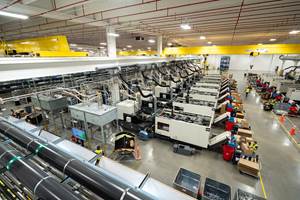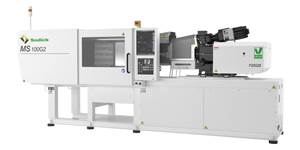First Foamed LSR Molding Uses Direct Gas Injection
Updated horizontal and vertical presses and robots were some of the attractions at the annual conference and technical exhibition of Arburg GmbH in Lossburg, Germany.
Updated horizontal and vertical presses and robots were some of the attractions at the annual conference and technical exhibition of Arburg GmbH in Lossburg, Germany. This year’s event marked the company’s 50th anniversary selling injection machines, celebrated with a “Golden Edition” press series. In addition, Arburg and several industry partners unveiled a significant innovation—foam molding of liquid silicone rubber (LSR)—and showed off an interesting new application of thermoplastic/LSR overmolding in a single tool.
Equipment update
In addition to five models of its new Allrounder C Golden Edition 50th-anniversary machines (re ported here in April), Arburg also demonstrated its new Allrounder 175 V, its first standard fixed-table vertical-clamp insert molder (Arburg also has a rotary-table T Series). Introduced last fall, the unit has a 15-ton C-frame clamp and either vertical or horizontal injection. It can mold parts from 1 to 40 g of PS.
In the view of Arburg officials, the highlight of the technology exhibit was a high-speed demonstration of the all-electric Allrounder 420A Alldrive. It molded two 8.6-g PP cups in a 2.2-sec cycle. That included an “extra” 0.3 sec to allow for robot take-out.
Speaking of robots, Arburg now offers its Multilift V traversing units for larger presses in the more compact single-beam version that is already available for smaller machines. Previously, only a dual-beam gantry style was offered for Allrounder 630S, 720S, and 820S machines of 250 to 400 metric tons. The servo-electric robot can carry up to 55 lb and boasts positioning accuracy to ±0.1 mm and speeds up to 4000 mm/sec on its main axes.
Leading-edge LSR
Arburg hosted a demonstration of a new processing technique that for the first time allows foaming of LSR during injection molding. Developed by Sulzer Chemtech AG in Switzerland, the Optifoam technique adds nitrogen or CO2 under pressure (1450 to 2900 psi) to both LSR components through metering units connected to each material feed line. Introducing the gas in a “supercritical” state enables the gas to diffuse fully into the LSR materials.
The gas-loaded LSR components come to gether in a special static-mixing manifold before entering the mold. “The static mixer is three to four times better than screw mixing, and it homogenizes with low shear forces,” says Joachim Studlek, manager of plastic processing, mixing, and reaction technology at Sulzer Chemtech Germany. Uniform distribution of gas into the material reportedly results in uniform foam cells.
Sulzer developed a special nozzle to prevent premature foaming in the barrel. Foaming occurs during injection as soon as the pressure is released. The mold requires an optimized venting system to allow gas to escape.
Foaming LSR reportedly can provide 30% to 60% weight reduction. Unfoamed LSR has a density of 1.1 g/cc, which can be reduced to 0.45 g/cc. Foaming also lowers Shore hardness by up to 50%, which gives a softer feel.
At Arburg, sample foam parts were molded using a delivery system from 2 Komponenten Maschinenbau (which has a Canadian office), a gas-delivery system from Maximator, specially optimized LSR materials from Dow Corning, a mold from Edegs-Formenbau, and an Arburg Allrounder 420 C 1000-250 hydraulic press with a special LSR barrel. The partners in the project have been working on LSR foaming since 2005.
A second interesting LSR demonstration at Arburg involved a two-zone mold with a rotating core that allows overmolding a thermoplastic (PBT) with LSR in one machine. The basic technology is not new, but the part design was more complex than usual, involving LSR overmolding in two places. The part is a six-pin electronic connector of 30% glass-filled PBT with an LSR insert in the connector face at one end and an LSR ribbed seal around the middle of the part (see photo).
The 4+4 cavity mold was built by Rico Elastomere Projecting GmbH in Austria. When the mold opens, the core-insert plate extends, rotates, and retracts; then the mold closes. The drive for the insert plate is integrated into the mold so that it can be used on other machines. Both components are produced with a “live” sprue for waste-free part production. Says Rico president Gerhard Kornfelder, “Liquid silicone requires a cold runner (around 77 F) and a hot mold (392 F), while the PBT uses a hot runner (572 F) and a “cold” mold (212 F).” The two zones are thermally isolated from each other.
Rico’s mold was mounted in an Arburg Allrounder 470 U with a vertical injection unit for the main thermoplastic component and a horizontal injector for the LSR. This configuration ensured easy access to the silicone feed. The part was molded in fully automatic operation with a cycle time of approximately 30 sec.
Related Content
IPEX Opens Injection Molding Facility in North Carolina
The pipe and fittings manufacturer’s new 200,000-square-foot facility represents a $200 million investment and will create 150 jobs.
Read MoreScaling New Heights With Vertical Integration
Eden Manufacturing was founded on a vision of vertical integration, adding advanced injection molding capabilities to a base of precision moldmaking and more recently bringing Swiss-type machining capabilities in-house.
Read MoreNiigata Machinery Shifts U.S., Canadian Sales and Service to Absolute Haitian
The transition expands Absolute Haitian’s product offerings to include Niigata injection molding machines alongside its Haitian and Zhafir lines.
Read MoreNext-Generation All-Electric and Vertical Injection Molding Machines
Sodick Plustech’s VR-G and MS-G2 Series both utilize the company’s proprietary V-Line technology, separating plasticizing and injection functions, and have upgraded displays, energy efficiency, response time and more.
Read MoreRead Next
Beyond Prototypes: 8 Ways the Plastics Industry Is Using 3D Printing
Plastics processors are finding applications for 3D printing around the plant and across the supply chain. Here are 8 examples to look for at NPE2024.
Read MoreLead the Conversation, Change the Conversation
Coverage of single-use plastics can be both misleading and demoralizing. Here are 10 tips for changing the perception of the plastics industry at your company and in your community.
Read More










